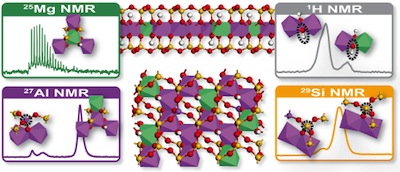Ask for a reprint
email :
* Give your email
2012
ACL
|
S.Cadars, R.Guégan, M.N.Garaga, X.Bourrat, L.Le Forestier, F.Fayon, T.V.Huynh, T.Allier, Z.Nour, D.Massiot, 'New Insights into the Molecular Structures, Compositions, and Cation Distributions in Synthetic and Natural Montmorillonite Clays', Chem. Mat. 24 4376–4389 (2012) doi:10.1021/cm302549k
We present a detailed investigation of the molecular structure of montmorillonite, an aluminosilicate clay with important applications in materials sciences, such as for catalysis, drug delivery, or as a waste barrier. Solid-state 29Si, 27Al, 25Mg, and 1H nuclear magnetic resonance (NMR) measurements combined with DFT calculations provide a comprehensive picture of the local structure and composition of a synthetic clay and of its naturally-occurring analogue. A revised composition is proposed based on Solid-State NMR results that allow the identification and quantification of the signatures of otherwise undetectable non-crystalline impurities, thus largely complementing the traditional elemental analyses. Solid-state 1H NMR at fast magic-angle spinning (MAS) and high magnetic field provide quantitative information on intra- and inter-layer local environments that are crucial for the determination of the amount of Mg/Al substitution within the octahedral layer. In combination with DFT calculations of energies, it suggests that pairs of adjacent Mg atoms are unfavorable, leading to a non-random cationic distribution within the layers.
|

|